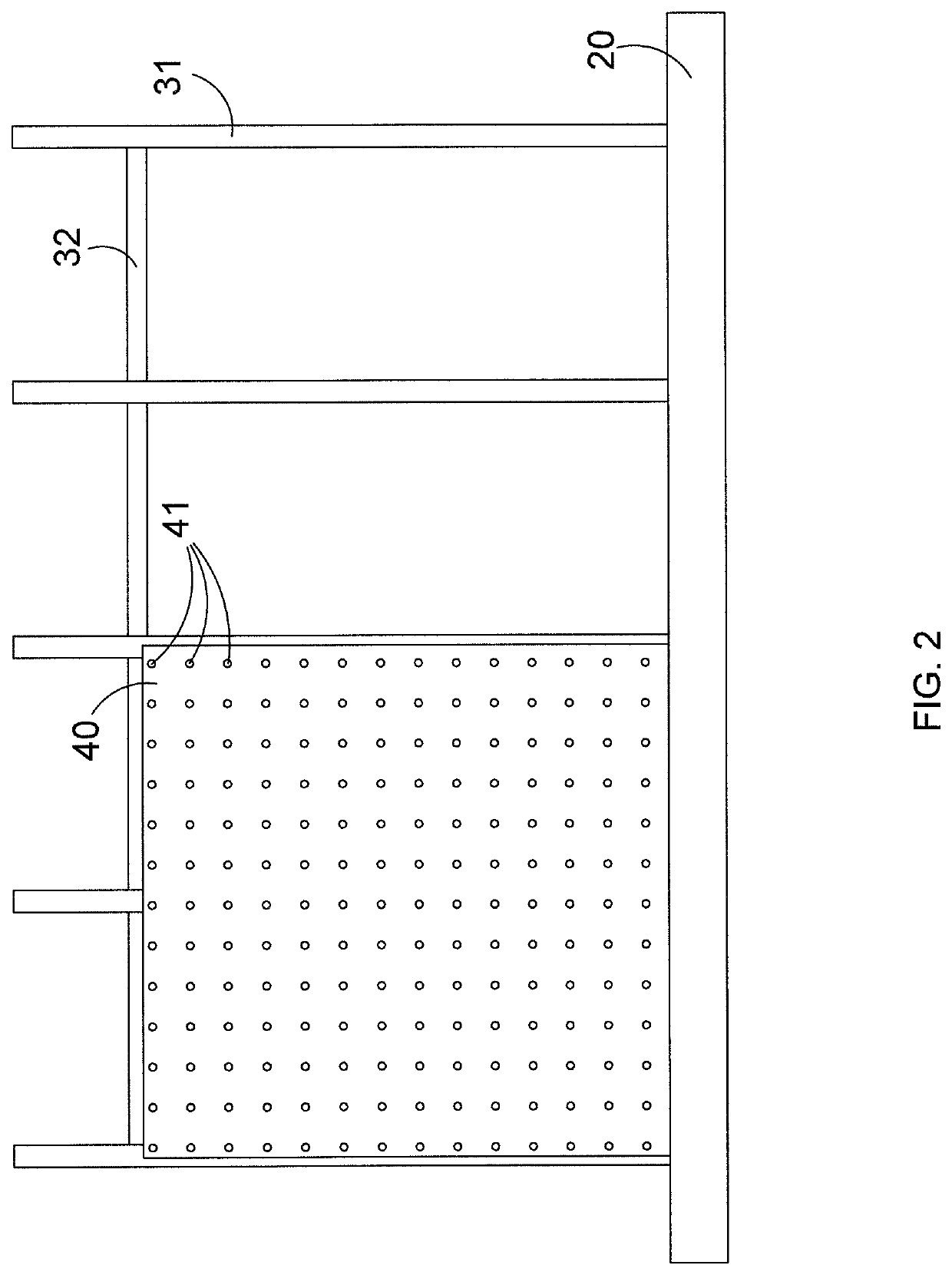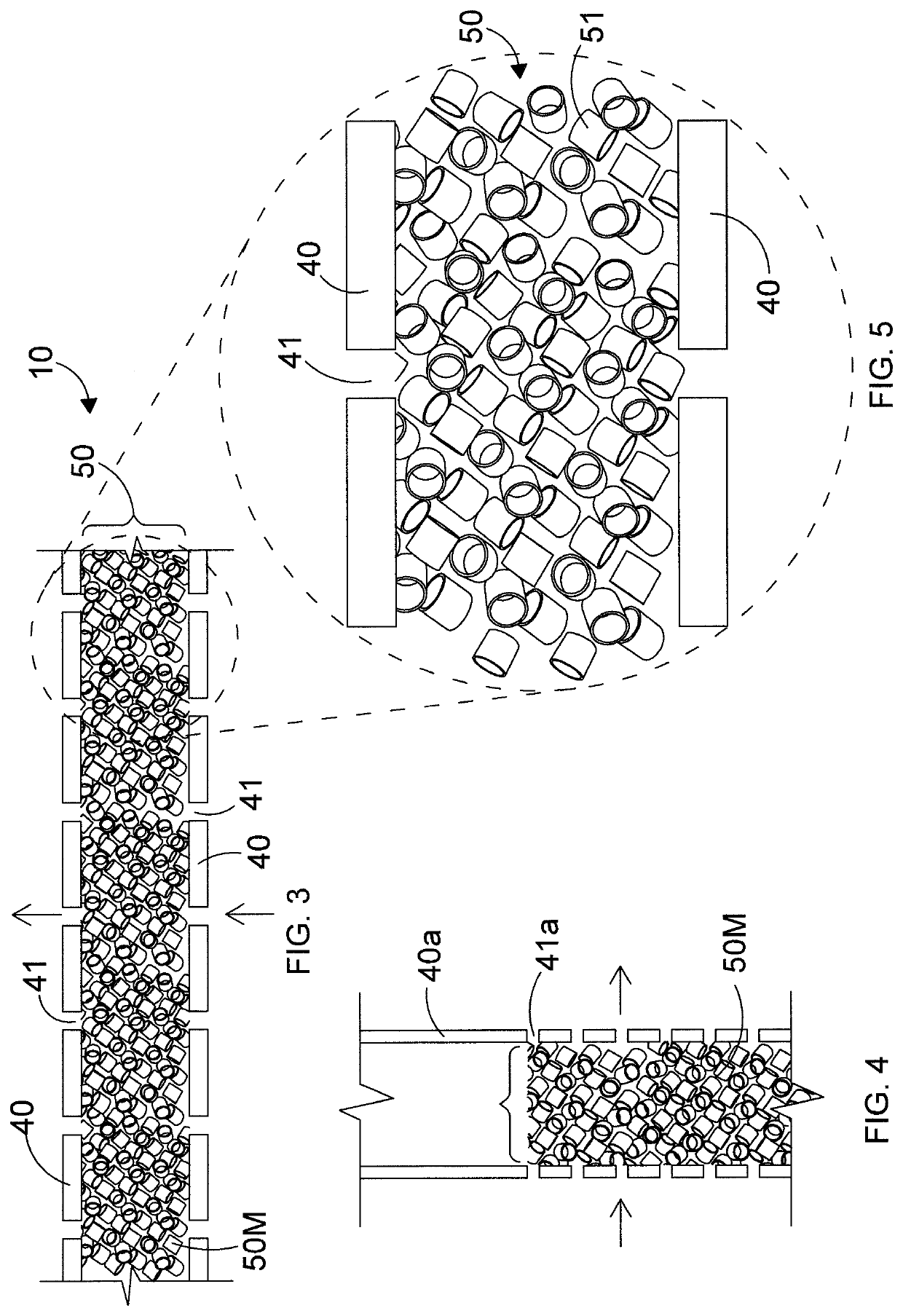Barrier assembly
a barrier and assembly technology, applied in the field of barriers, can solve the problems of escaping toxic gases, a significant risk to the life and health of third parties in the vicinity of residential areas, and a significant risk to personnel working around oil fields or operating/refining plants, and achieve the effect of increasing the surface area
- Summary
- Abstract
- Description
- Claims
- Application Information
AI Technical Summary
Benefits of technology
Problems solved by technology
Method used
Image
Examples
example 1
[0072]The apparatus of FIGS. 1-5 was used in a test as follows: A source of H2S gas was allowed to escape from a gas source upstream of the barrier assembly of FIGS. 1-5. A hypothetical target located 200 m downstream of the gas source and on the other (downstream) side of the barrier assembly comprised a sensor capable of detecting the gas concentration at a height of 1.7 m. The sensor measured the gas concentration at the downstream location. The criterion for the test was that at least the concentration threshold of H2S of 600 ppm should be reached within 75 seconds of initiation of gas release. The 75 s time limit corresponds to an estimated time required to put on a mask. The barrier assembly, 5 m high and 20 m wide, comprised a perforated vertical wall having an empty space fraction of 25% obtained with ¼″ holes spaced at approximately W. The target located 200 m from the release source was affected by a concentration of approximately 200 ppm after 75 s. It is confirmed the ef...
example 3 (
Passive Wall)
[0088]It is considered a vertical perforated barrier located at 15 m from the release of gas. Void fraction is 25% and holes size ¼″. The dimensions of the wall (i.e. barrier) are the same as the barrier of example 1.
[0089]It is considered the horizontal release of gas, the release size is 50 mm (hole size) and the position of the hole is @ 1 m above ground.
[0090]A gas flow (release pressure 150 barg, temperature 80° C.) with the following composition: methane as main component (97% mol) and H2S concentration at 3% mol / mol is directed toward the wall.
[0091]On the other side of the wall (outlet) the gas stream is calculated, by means of fluidodinamics simulations (using the same method as described in example 2), at 5 meters before the barrier, 150 meters after the barrier and 200 meters after the barrier.
5 meters 150 meters 200 meters beforeafterafterthe barrierthe barrierthe barrierppm H2SPerforated barrier 47459867(Void fraction 25%. Holes size ¼″)
example 5 (
Reactive Wall)
[0098]It is considered a porous barrier, filled with commercial scavenger R7J (i.e. a H2S scavenger) produced by Sulfatrap®, whose composition is reported below in table 1, whose diameter is 70-100 mesh, the thickness of the scavenger filling is 16 cm.
[0099]A gas flow (gas flow rate: 0.25 m s−1, temperature: 25° C.) with the following composition: 14,99% H2S and 85.01% N2, is directed toward the wall.
[0100]On the other side of the wall (outlet) the gas stream is detected after 1 minute and analyzed with a gas chromatograph.
[0101]The gas flow composition on the other side of the wall (outlet composition) shows a sharp decrease of H2S (H2S content: 33 ppm, N2: one hundred complement).
[0102]Therefore, there is a sharp reduction of the toxicity for a person present on the other side (outlet) of the wall.
TABLE 2Chemical composition of the commerical sorbents and their Sulphur Absorbent CapacityActivatedAluminiumAluminioCopper IICopperIron IIICharcoalOxideSilicateHydroxideOx...
PUM
 Login to View More
Login to View More Abstract
Description
Claims
Application Information
 Login to View More
Login to View More - R&D
- Intellectual Property
- Life Sciences
- Materials
- Tech Scout
- Unparalleled Data Quality
- Higher Quality Content
- 60% Fewer Hallucinations
Browse by: Latest US Patents, China's latest patents, Technical Efficacy Thesaurus, Application Domain, Technology Topic, Popular Technical Reports.
© 2025 PatSnap. All rights reserved.Legal|Privacy policy|Modern Slavery Act Transparency Statement|Sitemap|About US| Contact US: help@patsnap.com



